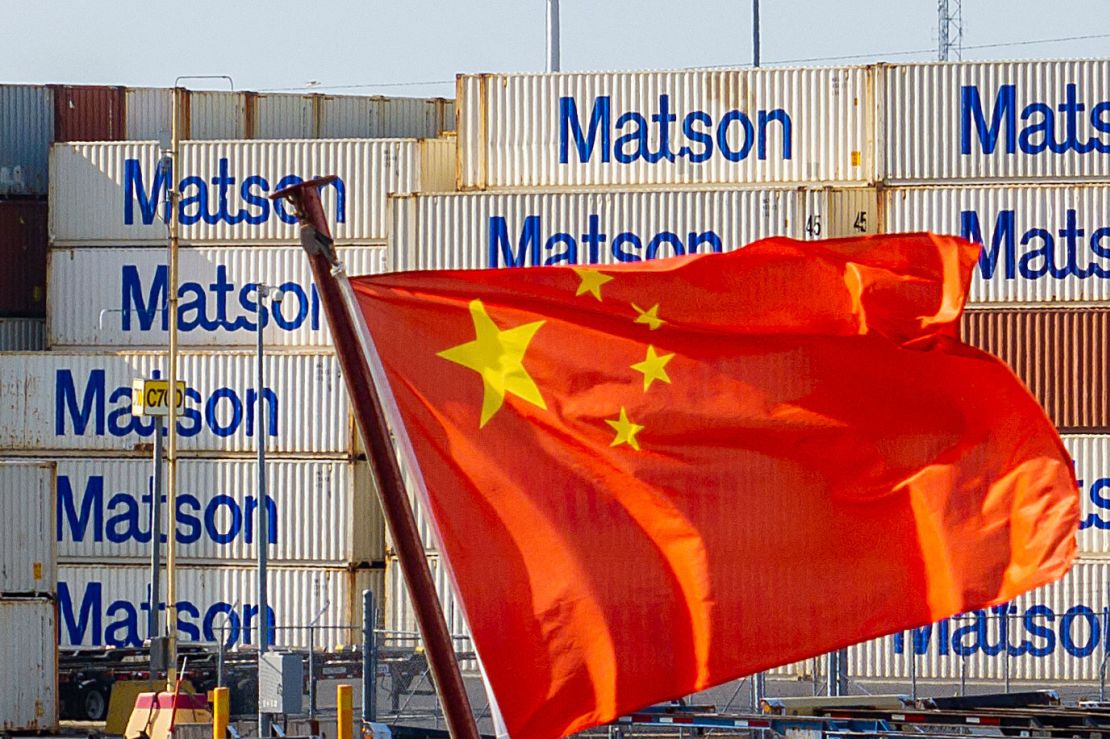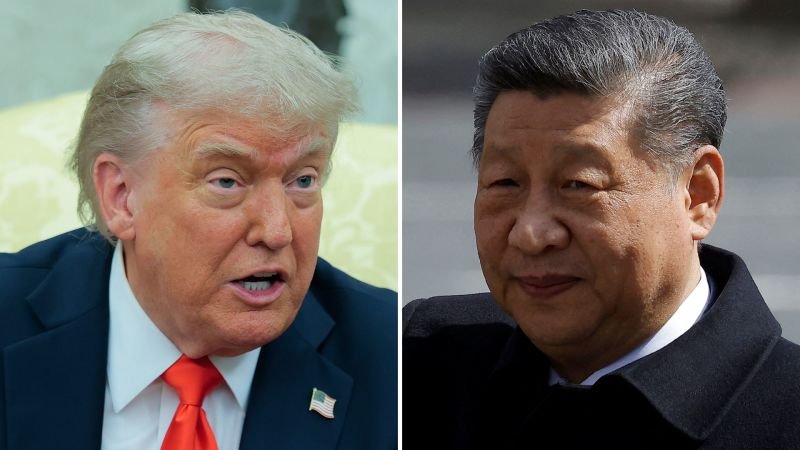Hong Kong
CNN
—
The fragile trade truce between the United States and China has, for now, been pulled back from the brink.
US President Donald Trump finally got his long-anticipated phone call with Chinese leader Xi Jinping, during which the two agreed to resume trade talks that had stalled over accusations from each side that the other had reneged on previous promises.
Thursday’s 90-minute conversation brought a temporary reprieve from an escalating feud between the superpower rivals, but it offered no clear path toward resolving their deep-rooted divisions – especially over crucial supply chains that both sides consider vital to national security.
US officials accused China of backpedaling on its pledge made during May talks in Geneva to ease export restrictions on rare earth minerals critical to a wide range of industries. Beijing, meanwhile, has bristled at Washington’s moves to warn companies against using China’s most advanced AI chips, restrict chip design software sales to China and “aggressively revoke” Chinese student visas.
“After what happened during the past 10 days, I already call (the phone call) a win,” said Yun Sun, director of the China program at the Washington-based Stimson Center think tank.
“Both sides acknowledge that this was a positive interaction, and the two leaders coming together can solve problems. It’s good for their strong man image and leadership credentials.”
While Trump had repeatedly expressed keenness for the call, including complimenting Xi’s toughness in a late-night social media post this week, Xi has taken his time in picking up the phone.
“The Chinese state is under significantly less pressure than its American counterpart in coming to the negotiating table,” said Brian Wong, an assistant professor at the University of Hong Kong. “The Chinese leadership joined the call from a position of political strength, even whilst economic concerns are very much alive and real.”
Trump’s eagerness to talk – and his speediness in declaring that he had “straightened out” the dispute over rare earth exports with Xi – has once again demonstrated to the Chinese leader just how powerful his nation’s dominance in the sector is.
Since April, when China announced the export controls, the new system has disrupted the shipment of the minerals, raising alarms among officials and businesses alike in Europe and America.
In the Chinese readout, Xi insisted that China had “seriously and earnestly” complied with the agreement, even as US officials have repeatedly accused Beijing of slow-walking approvals for rare earth exports.
Wu Xinbo, director of the Center for American Studies at Fudan University in Shanghai, noted that official rules dictate that applications for export licenses can take up to 45 working days to be approved.
“In principle, I can agree to export to you, but I can speed things up or slow them down. In reality, on a technical level, it also depends on the overall bilateral trade and economic atmosphere,” he said. “If the bilateral relationship is good, then I’ll go a bit faster; if not, I’ll slow down. But you can’t say I’m violating the agreement — I’m still following the standard procedures.”
While American businesses are likely to see more export licenses approved in the next couple of weeks, according to Wu, the export control regime is here to stay.

Zhiqun Zhu, director of the China Institute at Bucknell University in Pennsylvania, put it more bluntly, calling China’s dominance on rare earths “one of the few cards” it holds in the trade war.
“Why would the US government expect China to give up the rare earth card to please the US if it treats China as the enemy?” he wrote in an article prior to the Trump-Xi call.
In the days leading up to the phone call, Chinese scholars have suggested that Beijing should use its leverage on rare earths to get Washington to ease its own export controls on cutting-edge chips. Unlike rare earths, China doesn’t dominate this industry at the highest levels, and it views any supply bottleneck on the US side as an obstacle to its technological development.
Following his conversation with Xi, Trump announced that Commerce Secretary Howard Lutnick will join Treasury Secretary Scott Bessent and Trade Representative Jamieson Greer in the next round of trade talks.
That was noted by observers in both China and the US as a sign that US export controls may now be up for negotiation in a potential win for Beijing.
“The US Department of Commerce is responsible for export controls, which means that in the next stage, China-US negotiations will likely go beyond tariffs and also address issues such as export controls and entity sanctions,” Wu said.
During his first term in office, Trump lifted a ban on American companies doing business with Chinese telecom giant ZTE at Xi’s request to get a trade deal. But six years on, easing export controls on China will be a tough sell in Washington, where blocking Beijing’s access to advanced American technologies has become a rare bipartisan issue.
“Just having Lutnick there (in the trade talks) doesn’t mean that the US is going to make concessions on semiconductors,” Sun said.
She predicts more flare-ups of tensions down the road. “This ‘three steps forward two steps back’ is going to be the norm from now on. We’re not going to see a deal agreed without any drawbacks, and we’re going to see this repeating itself,” she added.
While the call signaled temporary relief, it also exposed stark differences in how the US and China approach their trade disputes: Trump tends to treat trade as a primary and standalone issue, whereas Beijing often views it in the context of broader bilateral relations.
Trump said in his Truth Social post that the hour-and-a-half conversation phone call was “focused almost entirely on TRADE,” while the Chinese readout singled out Xi’s stern warning on Taiwan – the reddest of lines for Beijing – and the issue of Chinese student visas.
The Chinese leader urged the US to “handle the Taiwan question with prudence” so that “‘Taiwan independence’ separatists” will not be able to “drag China and America into the dangerous terrain of confrontation and even conflict.”
The contrast strikes at the core of the gulf between China and the US, Wong said.
“Whilst Trump views the competition through primarily trade surplus/deficit terms, Xi views territorial integrity as … more important than the country’s economic interests,” he said.
From Beijing’s perspective, there are plenty of worrying signs. Last weekend, US Defense Secretary Pete Hegseth warned Asian allies that China posed an “imminent” threat to Taiwan, a self-governing democracy Beijing views as its own and has vowed to take control of, by force if necessary.
Days before, Reuters had reported, citing US official sources, that Washington plans to ramp up weapon sales to Taipei to a level exceeding Trump’s first term as part of an effort to deter China’s intensifying military pressure.
Another issue of concern for Beijing is the fate of Chinese students in the US. Last week, Secretary of State Macro Rubio, a known China-hawk, announced a plan to “aggressively revoke” visas for Chinese students, a move that has caused widespread anxiety and anger in China.
The Chinese readout quoted Trump as saying that Chinese students are welcome in the US. Trump later told reporters in the Oval Office: “Chinese students are coming. No problem. No problem. It’s our honor to have them.”
Wu said the adjustment of the visa policy will be a test of Trump’s leadership. During their call, Xi told Trump that the two leaders should “take the helm and set the right course” for bilateral relations, saying it’s particularly important to steer clear of “various disturbances and disruptions.”
“This remark had a clear target – it implies that within Trump’s team, there are people trying to disrupt or undermine the bilateral relationship, so now it’s up to President Trump to show leadership,” Wu said.

